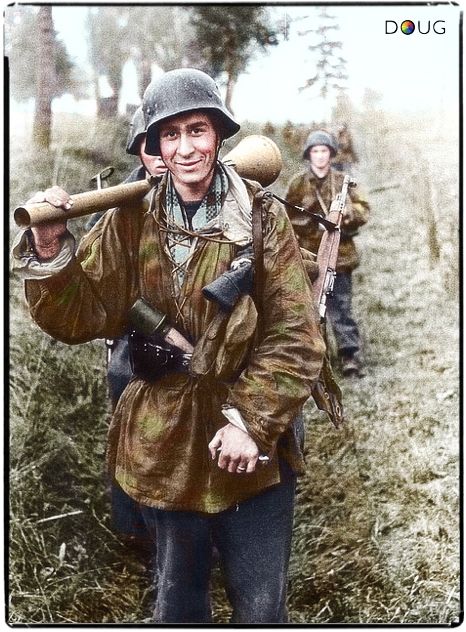
The 19th and 20th Luftwaffe Field Divisions (LFD) were part of the 3rd wave of infantry divisions formed from air force personnel in France in March 1943. Recruits and officers came from the XIII FliegerKorps. Flieger-Regiment 23 was a training unit for pilots and ground personnel in Russia and it was absorbed into the 20 LFD. As they were forming, some units were transferred over to the 44th Infantry Division and 24th Panzer Division. In June 1943, the 19th LFD was moved to Holland and the 20th LFD to Denmark to act as occupation forces.
In November, the General Staff had begun to make plans to absorb the Luftwaffe Field Divisions into the Army but Hitler blocked this change. Instead, he designated the 20 LFD as a mobile formation. The Army transferred some Cavalry officers and NCOs into this unit. Since trucks were not available, the division formed into bicycle (“radfahr”) regiments and the artillery regiments were fully mobilized. The flak and artillery battalions were armed with Soviet and Polish guns after having to give up their assault guns to units at the Russian front. Just before their transfer the Luftwaffe field divisions were renamed as Luftwaffe-Strum Divisionen or Airforce Assault Divisions, probably to deceive the Allies and give the units more prestige.
19th LFD
In June 1944, the 19th LFD was ordered to move to Italy, where it entered defense duty at Livorno(Leghorn) under the XIV Panzer Corps. The 19th & 20th LFD were placed in the FRIEDA Line on the right flank of the XIV Army near Piombino. The 19th LFD fought fierce rear-guard battles near Castagneto and Monteverdi. The US 36th “Texas” Infantry Division launched an attack on 24 June that crossed the Ombrone River and advanced to Montepescali. The 19 LFD escaped along the coastal Highway 1. On June 25th, the US 34th “Red Bull” Infantry Division replaced the 36th ID and continued to advance 15 miles to Highway 68.
The 19 LFD escaped from Piombino area and set-up a defensive position behind the Cecina River at the town of Cecina that featured a massive stone castle. The US 34th Division was strengthened by the US 1st Armored Division, as General Senger moved the 26th Panzer Division in to support the 19th LFD. The German front consisted of the 19 LFD next to the coast, then the 26 Panzer Division and next to it the 20 LFD. On July 3rd, the American 6th Corps launched a ferocious attack. The 19 LFD fought holding actions as it fell back to the coastal town of Rosignano-Solvay. They held off the Americans for a week with several fierce counter-attacks, but they were outflanked by the US 135th Infantry Regiment. The remnants of the 19 LFD withdrew to Livorno under pursuit by the US 133rd & 135th Regiments. By July 19th, the German line had retreated north of Livorno. The 19th Luftwaffe Field Division was ordered to disband late in July 1944. Much of the division was ordered back to Denmark where it was absorbed into the 19th Volksgrenadier Division.
20th LFD
The 20th LFD arrived in Italy in May 1944. By July it was providing coastal defense and anti-partisan force at Lucca with the bulk of the forces between Viareggio and La Spezia. On 12th of September, commander Major-General Wilhelm Crisolli was killed by partisans. Colonel Kasper Volcker assumed command but 2 months later he was captured. Soon after that the division was ordered to the X Army at the Adriatic coast where its 39th and 40th Jager Regiments were assigned to the 26 Panzer Division and the supporting units divided among the 29 & 90th Panzer Grenadier Divisions. On November 8, 1944, the order was given to disband the division. Many of the units transferred into the 155th Field Training Division. The 20th Anti-Tank Battalion became the 1048 A-T Battalion of the 148 Infantry Division. Two batteries of the 20th Artillery Regiment became part of 142nd Artillery Regiment of the 42nd Jaeger Division.
Generalmajor Wilhelm Crisolli was the Commander of the 20th Luftwaffe Field Division. He was killed in a partisan ambush near Bologna on September 12, 1944. This was a few weeks before the Germans launched a massive anti-partisan assault in the Bologna area, which became known as the Monte Sole massacre or the Massacre of Marzabotta. Reference Monte Sole Massacre, south of Bologna Sept 29- Oct 2. It is interesting that some units of the Herman Goring Division participated in this “mopping-up” action–sending Luftwaffe troops to take retribution for the killing of a Luftwaffe officer.
Reference: Göring’s Grenadiers, The Luftwaffe Field Divisions, 1942 – 1945, by Antonio J. Munoz, Axis Europa Publications, copyright 2002. ISBN 1891227408.